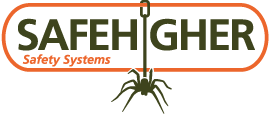Falls from height are a leading cause of workplace injuries and fatalities across many industries. Ensuring worker safety should always be a top priority, especially for those who regularly operate in environments where the risk of falling is high. At Safe Higher Safety Systems, we understand that fall prevention goes beyond compliance; it is about protecting lives. So, when seeking to prevent falls, what should priority be given to? Here, we explore the essential measures every business should take.
1. Risk Assessment
Before any work at height begins, a thorough risk assessment should be carried out. Identifying potential hazards and understanding the specific risks associated with the work environment is key. This assessment should include:
- The height at which the work will be performed
- The duration of the task
- The condition of the surface or structure being worked on
- Weather conditions (especially for outdoor work)
- The presence of any hazards such as fragile surfaces, electrical installations, or unguarded edges
Once identified, these risks should be carefully evaluated to determine the best course of action for minimising danger.
2. Elimination of Height Risks
Where possible, eliminating the need to work at height altogether should be the first course of action. Can the work be done from the ground or using other safer methods? For example, long-reach tools or automated systems might allow work to be done without exposing workers to the risk of falling.
By rethinking the approach to the task, businesses can often find safer alternatives that prevent the need to work at height, significantly reducing the risk of falls.
3. Use of Proper Fall Prevention Equipment
When work at height cannot be avoided, the next priority should be to implement measures that prevent falls from occurring in the first place. This includes:
- Guardrails: Permanent or temporary guardrails around work platforms, scaffolds, or roofs create a physical barrier, preventing workers from falling.
- Edge Protection Systems: These systems safeguard workers from unprotected edges where falls could occur.
- Safety Nets: Installed beneath work areas, safety nets offer an additional layer of protection, reducing the risk of serious injury should a fall happen.
By prioritising fall prevention over fall arrest, businesses can create safer environments and significantly reduce the risk of incidents.
4. Appropriate Fall Arrest Systems
If falls cannot be entirely prevented, fall arrest systems must be employed to mitigate the consequences of a fall. These include:
- Harnesses and Lanyards: Workers should be equipped with harnesses that are securely attached to a suitable anchorage point. Lanyards should be of appropriate length and strength to arrest a fall in the shortest possible distance.
- Anchor Points: Anchor points must be correctly rated for the forces involved in stopping a fall and positioned to minimise the risk of injury during a fall.
- Rescue Plans: If fall arrest systems are used, it’s crucial to have a rescue plan in place. Workers suspended in harnesses after a fall need to be rescued swiftly to prevent injury from suspension trauma.
5. Training and Competence
One of the most critical aspects of fall prevention is ensuring that workers are fully trained and competent in the equipment they are using and the tasks they are performing. Training should cover:
- Proper use of personal protective equipment (PPE)
- Safe work practices at height
- How to identify and report hazards
- Emergency procedures in case of a fall or accident
Regular refresher training is also essential to keep skills sharp and knowledge up to date.
6. Ongoing Inspections and Maintenance
Fall prevention equipment must be regularly inspected and maintained to ensure it remains in good working condition. This includes daily checks by workers using the equipment, as well as periodic inspections by qualified professionals.
- Guardrails and scaffolding should be checked for stability and wear.
- Harnesses and lanyards should be examined for signs of damage or wear and tear.
- Anchor points should be regularly tested to ensure they meet safety standards.
Proper maintenance can prevent equipment failures that could lead to serious accidents.
7. Creating a Safety Culture
Finally, creating a culture of safety within the workplace is essential for the prevention of falls. Safety protocols should be clearly communicated, and workers should feel empowered to speak up if they spot potential hazards or unsafe practices.
At Safe Higher Safety Systems, we believe that everyone plays a role in maintaining a safe work environment. By fostering a proactive approach to safety and ensuring that workers understand the importance of their actions, businesses can significantly reduce the risk of falls.
Conclusion
Preventing falls from height requires a multifaceted approach, where priority is given to identifying and eliminating risks, implementing the proper safety measures, and ensuring that workers are well-trained and equipped. At Safe Higher Safety Systems, we specialise in providing comprehensive risk assessments, testing, certification, and safety solutions to keep your workforce secure. By putting safety first, businesses can not only comply with regulations but also protect their most valuable asset – their people.
For more information on how Safe Higher Safety Systems can help your business prevent falls from height, contact us today.
